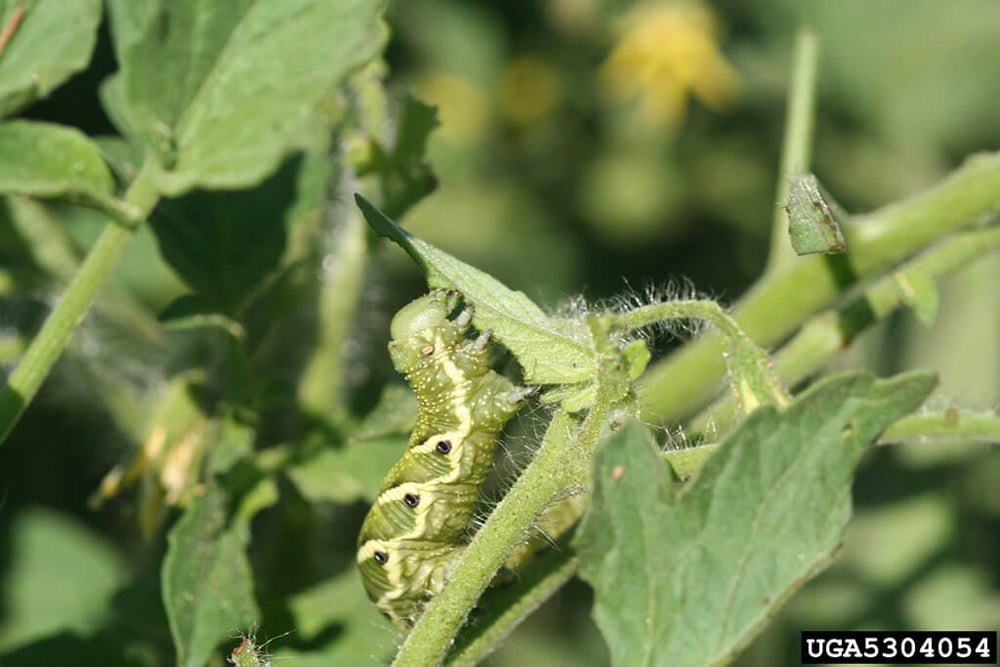
Hornworms: They look as unattractive as their name sounds. These destructive pests can grow up to 4 inches long and have distinctive horns on their rear ends. They can quickly decimate a tomato patch and will also eat a host of other garden veggies. But take heart: By following a few prevention tips and taking quick action when hornworms appear, you can keep them from ruining your precious plants.
How to get rid of hornworms.
What are hornworms?
Hornworm caterpillars are the larvae of the hummingbird (or sphinx) moth, which gets its name from its fast wing speed. If you spy these whirring moths hanging in mid-air and sipping nectar from flowers in your garden (usually at dusk or later), you need to keep an eye out for hornworm caterpillars.
There are a couple of types of hornworms. The tomato hornworm has a black horn; the tobacco hornworm has a red horn. They each feed on tomatoes and its plant relatives, including eggplants, peppers, and potatoes.
What do hornworms do?
Adult moths lay eggs on host plants. They look first for tomato plants, but will also attack eggplants, peppers, and potatoes. When eggs hatch, the hornworms start eating. Full-grown hornworm caterpillars can devour an entire tomato plant in a day or two.
How do I know if I have hornworms?
Hornworms can be hard to see initially because their color blends in well with green plant foliage. They tend to hide during the day beneath leaves and emerge to feed at dusk, so that tends to be the easiest time to spot them.
You'll recognize them by their giant size (up to 4 inches long) and the characteristic "horn" on their rear end. They typically appear in late spring and summer.
One of the best clues that a hornworm is present are the barrel-shaped droppings they leave scattered on leaves. If you see these, you're likely to find hornworms nearby—be sure to look especially carefully in the area right above the droppings.
How do I prevent hornworms?
Preventing hornworms takes, ideally, a team effort between you and a host of beneficial insects and birds. Here's what to do.
- Keep weeds pulled. Adult hummingbird moths lay eggs on a variety of weeds in the tomato family, including horsenettle, jimsonweed, and nightshade. Keep these plants away from your garden. In fact, they host so many tomato plant family pests that it's a good idea to pull them anywhere they appear in your yard.
- Attract beneficial insects. Many insect predators attack tomato hornworms. Ladybugs and green lacewings feast on eggs and young worms. One type of small wasp also attacks hornworms, laying its eggs under the pest's skin; when the larvae hatch, they feed on the hornworm. To attract beneficials, limit pesticide use. Grow a large variety of flowering plants, especially sweet alyssum. Also, consider allowing a few vegetable and herb plants, such as lettuce, broccoli, and parsley, to flower. Beneficial insects love the nectar those blossoms provide.
- Hang birdhouses. Insect-eating birds, such as house wrens and chickadees, are happy to live near people. These curious birds devour many insects, including hornworms.
How do I get rid of hornworms?
When it comes to getting rid of hornworms, you have a range of options depending on the severity of the infestation and your comfort level with creepy-crawlies.
- Hand-pick worms. Because they're usually not present in large numbers, you can often control hornworms by simply handpicking them off of plants and destroying them (the horn is harmless). Drop them into soapy water or feed them to the chickens if you have them.
- Break out the spray. If you'd rather not handle the worms, dust or spray plants with a product like Ortho® Insect, Mite & Disease 3-in-1 or any caterpillar spray containing a naturally occurring bacterium called Bacillus thuringiensis (Bt), as directed on the label. (Bt is an organic biopesticide that acts only on certain species of caterpillars and doesn't harm beneficial insects.) Once treated, healthy plants should recover by producing new foliage.
- Leave parasitized worms alone. If you see a hornworm with white oval things protruding from its body, leave it in the garden. It has been parasitized by a braconid wasp, and the white objects are cocoons. More wasps will emerge from the cocoons to attack other hornworms.
Need more info and local pesticide recommendations? Contact your regional Extension agent. You can find the nearest Extension office through the Cooperative Extension System map.
Tomato and tobacco hornworms can make for some cringeworthy garden pests. However, with a few preventative measures and by taking quick action when they do appear, you can help minimize the damage.






 Herbs
Herbs
 Vegetables
Vegetables
 Fruit
Fruit
 Flowers
Flowers
 Succulents
Succulents


